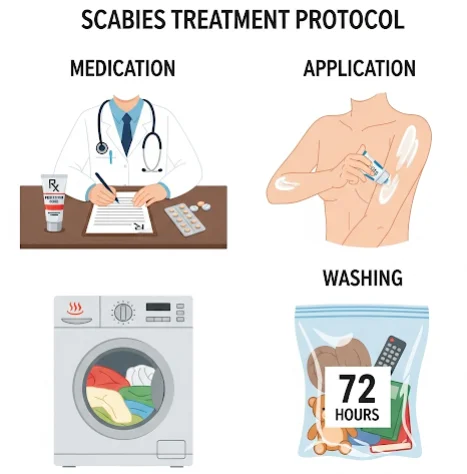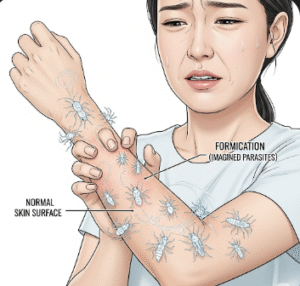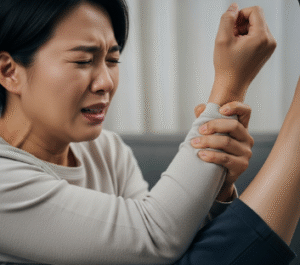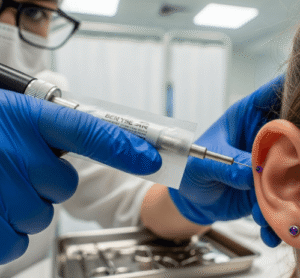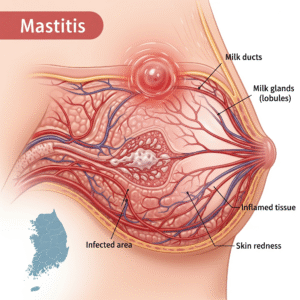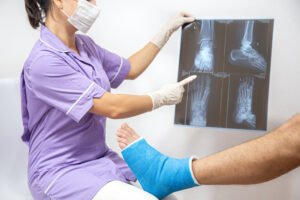What It Is
Defining Scabies
→ Scabies is a highly contagious skin infestation caused by the Sarcoptes scabiei mite, a microscopic parasite that burrows into the skin.
→ It spreads primarily through close skin-to-skin contact, but also through shared clothing, bedding, or towels.
→ The infestation causes intense itching, red bumps, burrows, and widespread rash, particularly at night.
→ In Korea, dermatology clinics and hospitals follow structured treatment protocols to eliminate mites, manage itching, and prevent reinfection.
Key Characteristics
- Severe nighttime itching
- Red bumps or burrows on fingers, wrists, elbows, waistline, and genitals
- Widespread rash in severe cases
- Highly contagious, often affecting entire families or communities
- Can lead to secondary bacterial infection if untreated
Why It’s Done
Main Reasons for Treatment
➡ Symptom Relief – Severe itching disrupts sleep and daily comfort.
➡ Preventing Spread – Scabies can quickly infect family members, classmates, or co-workers.
➡ Preventing Complications – Untreated scabies can cause impetigo, eczema, or cellulitis.
➡ Cosmetic Recovery – Rash and lesions may cause embarrassment or distress.
➡ Eradication of Infestation – Protocol ensures mites and eggs are fully eliminated.
Alternatives
Non-Medical Options
- Strict Hygiene → Washing bedding, clothes, and towels in hot water.
- Vacuuming and Cleaning → Carpets, sofas, and mattresses disinfected to reduce reinfestation.
- Isolation of Personal Items → Clothing stored in sealed bags for at least 72 hours to kill mites.
Medical Alternatives
→ Instead of standard topical therapy, other options may include:
- Oral Ivermectin → Effective for widespread scabies or resistant cases; used cautiously in children under 15 kg and pregnant women.
- Topical Benzyl Benzoate → Used in some countries but less common in Korea due to irritation risk.
- Sulfur Ointments → Alternative for infants or patients intolerant to standard therapies.
- Antihistamines → For itch relief but do not kill mites.
Preparation
Before Treatment
➡ Dermatology Consultation – Diagnosis confirmed with skin scraping, dermoscopy, or microscopic examination of mites and eggs.
➡ Family and Contact Screening – All close contacts must be examined and treated simultaneously.
➡ Laundry and Cleaning Plan – Patients are advised to wash all textiles in hot water or isolate them.
➡ Patient Counseling – Doctors explain that itching may persist for 2–4 weeks after treatment even when mites are killed.
➡ Avoiding Self-Medication – Overuse of steroid creams can worsen symptoms or mask diagnosis.
How It’s Done
Standard Protocol in Korea
1. First-Line Therapy – Topical Permethrin 5% Cream
→ Considered the gold standard in Korea.
- Applied from the neck down (and on the scalp in infants/elderly).
- Left on for 8–12 hours before washing off.
- Reapplied after 7 days to kill newly hatched mites.
2. Alternative Topical Medications
- Sulfur Ointment (5–10%) → Used for infants and pregnant women.
- Crotamiton Cream → Provides relief but less effective alone; often used as adjunct.
3. Oral Therapy – Ivermectin
→ Prescribed for:
- Severe infestations (crusted scabies)
- Patients with immune deficiency
- Large outbreaks in institutions
- Typically given as a single oral dose, repeated after 1–2 weeks.
4. Antihistamines and Anti-Inflammatories
→ Reduce itching and allergic response to mite proteins.
- Loratadine, cetirizine, or hydroxyzine are commonly used.
5. Secondary Infection Control
→ If scratching leads to bacterial infection:
- Topical or oral antibiotics are prescribed.
- Korean dermatology clinics often monitor for impetigo or cellulitis.
Environmental Protocol
- All bedding, towels, and clothes washed in hot water (≥60°C).
- Non-washable items sealed in plastic bags for at least 3 days.
- Household contacts treated simultaneously to prevent reinfestation.
Recovery
Immediate Recovery
- Itching may worsen in the first week due to immune response.
- Redness and rash begin to improve after 1–2 weeks.
- Patients must avoid scratching to reduce risk of infection.
Long-Term Recovery
→ Most patients are free of mites after 2–3 weeks of treatment.
→ Post-scabetic itching may last up to a month but does not mean reinfection.
→ With proper protocol, recurrence rates are low, especially when all family members are treated.
Complications
Possible Risks Without Treatment
- Severe Itching and Insomnia → Affects daily life.
- Secondary Infections → Impetigo, cellulitis, or eczema from scratching.
- Crusted Scabies → Thickened, scaly skin with heavy mite burden, especially in immunocompromised patients.
- Outbreaks → Rapid spread in schools, daycare centers, nursing homes.
Risks of Treatment
- Skin Irritation → Burning, redness, or dryness with topical creams.
- Allergic Reactions → Rare with permethrin or ivermectin.
- Persistent Itching → Often mistaken for treatment failure but usually part of recovery.
Treatment Options in Korea
Why Korea Excels in Scabies Care
➡ Accurate Diagnostics – Dermoscopy and skin scraping widely available in clinics.
➡ Structured Protocols – Dermatologists follow stepwise guidelines to ensure full eradication.
➡ Access to Modern Medication – Permethrin and ivermectin are widely used in hospitals.
➡ Public Health Approach – Quick contact tracing and household management reduce outbreaks.
➡ Integration of Dermatology and Pediatrics – Specialized care available for children, elderly, and immunocompromised patients.
Patient Experience in Korea
- Diagnosis and treatment typically managed in outpatient dermatology clinics.
- Patients receive step-by-step hygiene instructions for home care.
- Follow-up visits ensure lesions are resolving and no reinfestation occurs.
- Families often treated together to prevent ongoing transmission.
Conclusion
Scabies treatment protocol in Korea follows a clear, stepwise approach that combines topical therapy, oral medications when needed, and strict hygiene measures.
Through permethrin cream, ivermectin, and environmental control, Korean dermatologists achieve high cure rates while minimizing recurrence.
Patients benefit from Korea’s emphasis on accurate diagnosis, family-based treatment, and public health prevention, ensuring both rapid recovery and long-term protection.
For individuals and families dealing with scabies, Korea provides some of the most reliable, comprehensive, and patient-centered treatment protocols worldwide.

